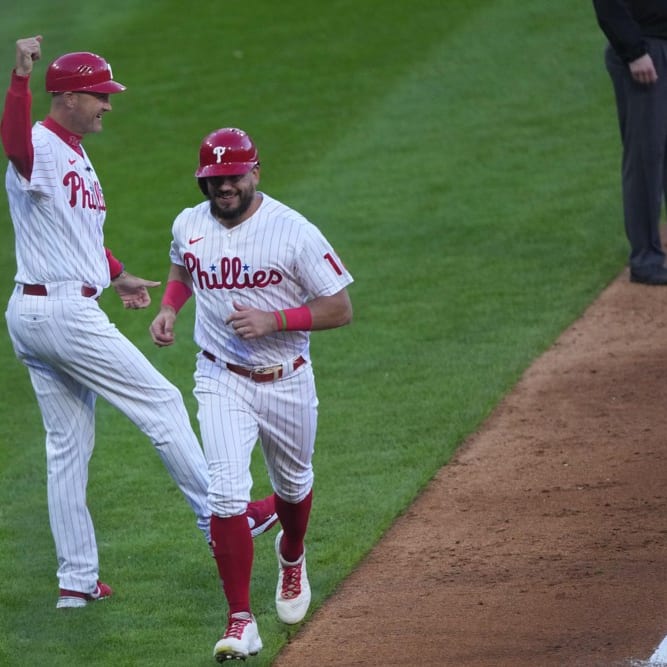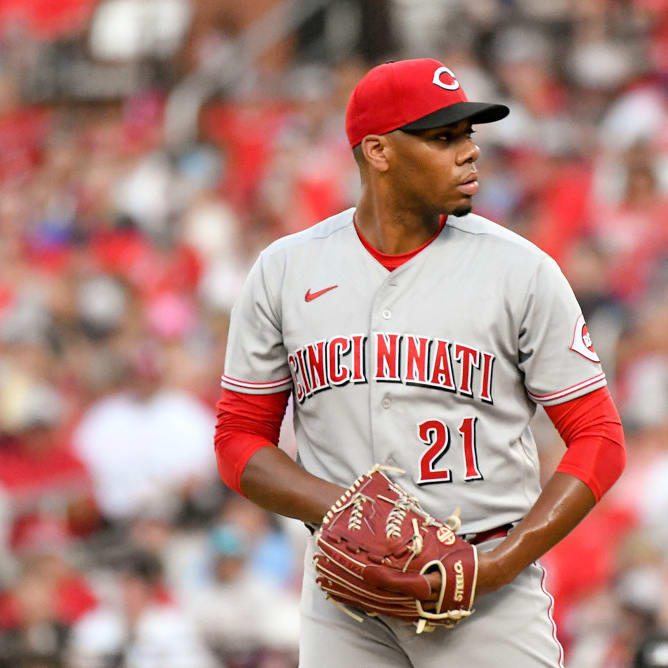This article is part of our The Z Files series.
One of the repercussions of the current pitching landscape is the need to make even snappier decisions when a pitcher goes on a hot streak. Is it real, or will he revert to his previous form? There was a time where sample size was the parachute. There isn't ample data, though, so why even try? This isn't to say we now have all the answers with Statcast and the like, but we can graduate from a dart throw to an educated guess.
Below are seven pitchers with solid July numbers, all an improvement over the first three months. Each will be put under the microscope with their underlying metrics dissected in order to judge the sustainability of their current performance level.
Reynaldo Lopez, Chicago White Sox
Lopez has been crushing it since the break. Some may point to the opponents (Athletics, Rays and Marlins) and contend he's taking advantage of weaker lineups, but that doesn't explain the marked difference in the quality of, and change to, his repertoire.
Over his last three outings, Lopez has added a couple ticks to his four-seamer, though the spin rate is about the same. Still, sitting 97 mph since the break has more than doubled his SwStr%, spiking from 8 percent to 17.6 percent.
Additionally, Lopez is throwing fewer changeups while edging up his curve and slider usage. Both latter offerings benefit from greater spin and sure enough, Lopez's spin rate on both is up several revolutions.
A 6.34 ERA before the break
One of the repercussions of the current pitching landscape is the need to make even snappier decisions when a pitcher goes on a hot streak. Is it real, or will he revert to his previous form? There was a time where sample size was the parachute. There isn't ample data, though, so why even try? This isn't to say we now have all the answers with Statcast and the like, but we can graduate from a dart throw to an educated guess.
Below are seven pitchers with solid July numbers, all an improvement over the first three months. Each will be put under the microscope with their underlying metrics dissected in order to judge the sustainability of their current performance level.
Reynaldo Lopez, Chicago White Sox
Lopez has been crushing it since the break. Some may point to the opponents (Athletics, Rays and Marlins) and contend he's taking advantage of weaker lineups, but that doesn't explain the marked difference in the quality of, and change to, his repertoire.
Over his last three outings, Lopez has added a couple ticks to his four-seamer, though the spin rate is about the same. Still, sitting 97 mph since the break has more than doubled his SwStr%, spiking from 8 percent to 17.6 percent.
Additionally, Lopez is throwing fewer changeups while edging up his curve and slider usage. Both latter offerings benefit from greater spin and sure enough, Lopez's spin rate on both is up several revolutions.
A 6.34 ERA before the break compared to 1.71 ERA after is a monumental difference. Obviously, even if the new skill level isn't maintained, Lopez should see a bump in his rest-of-season ERA. The good news is there's tangible evidence to believe much of what he's done is real and it's well worth taking the chance he remains a new guy down the stretch.
Eduardo Rodriguez, Boston Red Sox
Before delving into the numbers, it's refreshing to see skipper Alex Cora shower Rodriguez with tough love, extolling him to be more than a five-and-fly guy in an era where third time through is treated like a disease.
Rodriguez's changes are more subtle than Lopez's. The Red Sox southpaw is relying less on side-to-side movement and more on changing eye level using more pitches with vertical drop. Specifically, Rodriguez has chopped his cutter usage in half, down to just 10 percent, while all but abandoning the curve and slider. Instead, Rodriguez is deploying a few more changeups and two-seamers, both featuring sinking action. He's exhibiting better command in all four quadrants of the zone, improving pitch efficiency. This has allowed Rodriguez to work into the seventh in all three starts since the break, completing the frame twice.
Rodriguez's stuff is the same, he's just fine-tuned his repertoire. He's not really a new guy but is instead displaying continued maturation, an encouraging development from someone many have long expected to take the next step.
Anthony DeSclafani, Cincinnati Reds
DeSclafani's uptick started as he headed into the break, buoyed by adding 1.5 mph to his fastball. The interesting aspect of the added velocity is that it's a level he'd never reached previously, even before he was beset by some injury woes.
Simultaneous with the extra zip on his four-seamer was significantly better control. Over his first 16 outings, DeSclafani registered a 24.3 percent K% and a 6.9 percent BB%, compared to 29.6 percent and 4.2 percent in his last three efforts. In addition, DeSclafani is surrendering much less hard contact.
Home runs remain an issue. Herein lies the concern. DeSclafani needs the added velocity to help mitigate his generous allowance of long balls. This is necessary from both a real and a fantasy perspective. The newfound strikeouts add to his production while aiding in run prevention.
While the last three starts are encouraging, DeSclafani must demonstrate he can maintain a faster four-seamer. It's a leap of faith he'll do so. As such, he's still a matchup play, but if the extra oomph subsists through September, his 2020 baseline should reflect 2019's second half.
Danny Duffy, Kansas City Royals
The mere fact Duffy deserves attention reflects the state of pitching. That said, his 3.82 ERA since June 22 is over half a run below league average. If he can continue in that vein, Duffy would be a fantasy asset, especially in leagues where he can be spotted against the Tigers and White Sox. The intriguing thing is while Duffy's strikeout and walk rate have improved, he's giving up twice as many homers in the recent stretch. That said, if he maintains the improved peripherals while incurring some home run regression, his ratios could drop even more.
First, let's investigate why his whiff and walk rates are better since June 22. Duffy's pitch mix is the same, but he has gained one mph on his fastball. Perhaps this explains a modest 5 percent increase in SwStr%. His overall Swstr% over the two stretches were nearly identical but his K% lately is 23 percent, compared to 20 percent earlier. This could be variance or perhaps the result of different sequencing, as Duffy has been using his slider a lot more with two strikes. The odd thing is the SwStr% on his slider was 18 percent before dropping to 10 percent in his recent efforts.
This next-level analysis is interesting, but there isn't anything glaring to hang your hat on. It's likely variance. The one interesting point is he's using his slider more but getting fewer swinging strikes. If the pitch reverts to its early levels, we'd have an actionable difference. As is, Duffy's recent success moves the needle, but only to the point of streaming in favorable matchups. I'm going to track slider usage and effectiveness and if it improves, Duffy could be trusted more often.
Zac Gallen, Miami Marlins
Gallen has only six appearances, so sample size considerations abound. Still, the last three are appreciably better than the first three and as was discussed in the opening, we can't afford to wait. If Gallen can make a difference the final two months, we need to move now.
Instead of comparing the two three-game stints, the focus will be mostly on the last three with an eye towards how much of the success was skills-based as opposed to luck. That said, there aren't any noticeable trends with respect to arsenal or quality other than maybe declining cutter usage. It appears Gallen either game plans for each team or sticks with what is working. For instance, in his last effort, Gallen dropped the frequency of his four-seamer while tossing more soft stuff, particularly curves and changeups.
To be honest, it looks like Gallen was a bit unlucky when he first arrived, then quite fortunate in his recent efforts. Further, while a 28 percent K% is impressive, his 12 percent swinging strike mark translates to a strikeout rate around 24 percent. Gallen's team context is mixed. There isn't a better home park in the league, but his run support will be tepid. Gallen remains a matchup play.
Jeff Samardzija, San Francisco Giants
Usually, when a veteran of Samardzija's ilk makes a list of this nature, it's dismissed as a hot streak with, "He'll just burn me when I pick him up." This is even more reason to do a little digging. Maybe he will, maybe he won't.
Samardzija had enjoyed a solid July with a 2.70 ERA and 0.82 WHIP this month, backed by 24 punchouts with just a trio of bases on balls in 26.2 innings. For the month, his strikeouts are up while his walks are down. The obvious question is, can this be sustained? It would help if he's been doing something different in terms of pitch mix.
What makes it tough in this regard is Samardzija tends to adjust per team. His four-seam usage is consistently around 25 percent but he'll alter the secondaries. That said, in the aggregate he's using his two-seamer a lot more in July, cutting back on his curve, slider and split. Furthermore, over the past month, only 36 percent of Samardzija's two-seamers have been called a ball compared to 42 percent previously.
It's still a guess whether this is planned or happenstance, but Samardzija's improved control seems to be a result of a greater reliance on, and better execution of, his two-seam fastball. Perhaps it's a chicken/egg scenario, but so long as he maintains the trend, it doesn't matter. We've seen solid stretches from the veteran before, this is enough for me to use Samardzija, especially at home. The fact others are still avoiding him just increases his availability.
Jakob Junis, Kansas City Royals
Cutting to the chase, Junis K% has spiked his last three starts. The thing is, his SwStr% has gone up, but not enough to account for the 6 percent increase in K%. This usually is an indication of good luck but can be reflective of a change resulting in more called strikes, as swinging strikes and strikeout rate correlate but there are other factors.
In his three post-break outings, Junis has markedly altered his pitch mix, throwing 5 percent more four-seamers and more than doubling his curve usage to 23 percent. He's using his slider and sinker 9 percent less. The quality of his fastball and curve aren't different relative to velocity and spin, he's just incorporating them more into his arsenal.
The fact this occurred after the respite lends credence to the narrative that it's purposeful, though it remains to be seen if it continues and remains effective. I've always had a soft spot for Junis, expecting growth into the next level, so maybe this is a bit of confirmation bias, but my optimism isn't waning.










